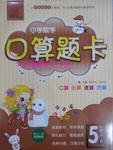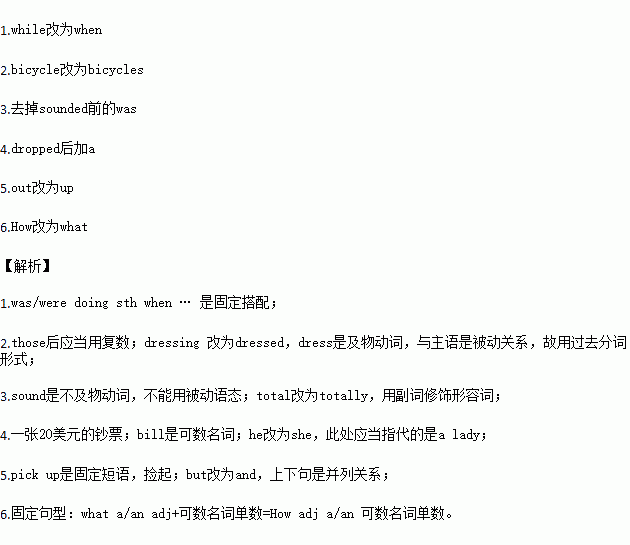题目内容
第一节:短文改错(共10小题;每小题1分,满分10分)
假定英语课上老师要求同桌之间交换修改作文,请你修改你同桌写的以下便条。便条中共有10处错误,每句中最多有两处。错误涉及一个单词的增加,删除或修改。
增加:在缺词处加一个漏词符号( ),并在其下面写出该加的词。
删除;把多余的词 用斜线( \ )划掉。
修改:在错的词下划一横线,并在该词下面写出修改后的词。
注意:1;每处错误及修改均仅限一词;
2.只允许修改10处,多者(从第11处起)不计分。
The other day after work, I was walking down the street while I saw a boy riding a nice unicycle, one of those bicycle with only one wheel. Dressing in all pink from head to toe, he was singing a song which was sounded like a kid’s song. I thought he must be total crazy. Just then, a lady dropped 20-dollar bill on the ground, but he didn’t realize it and started to walk away. The guy in pink picked out the money and gave it back to her. After that, he rode on but soon disappeared before the lady could thank him. How a strange and good guy!
 口算题卡北京妇女儿童出版社系列答案
口算题卡北京妇女儿童出版社系列答案At Japan’s Studio Ghibli, which has produced extraordinary animated films(动画片)since 1985, the best-known figure has always been one of the company’s founders, Hayao Miyazaki.
But an equally key figure is co-founder Isao Takahata, who has recently made a new feature, The Tale of Princess Kagnya. It is an unforgettable feature with an unusual hand-drawn aesthetic(美感).
The title character is a tiny baby girl who appears in a bamboo plant. She is found by a woodcutter, who takes her home and brings her up. He believes the little girl is a princess, and sets about preparing what he regards as a suitable world for her.
This original story is the oldest work of fiction in Japan; every child knows it in its simplified folktale form.
“It is a fascinating story with elements of wonder, humour, and sorrow,’’ Takahata says, “but these three elements are scattered(分散)about.” The chief challenge for anyone trying to adapt it is that “we are completely unable to comprehend what was in the heart of Princess Kaguya. Because of this, despite its being well known, few people consider it interesting. There have been several attempts at making a film out of the story, but they ended up being abandoned.”
He was connected with one of these attempts, but no one paid any attention to his concept.
“Fifty-five years later, I thought my concept was still appealing, and used it as a basis for turning the story into a feature film.”
His concept involves the princess’s origins, her expectations and her access to “the full range of human emotions”.
To realize his vision, Takahata says, “I needed to take the extremely individualistic brushwork and key designs of Osamu Tanabe and Kazuo Oga, two brilliantly talented artists, and have them permeate(扩散)throughout the film. The two of them drew many pictures, but they weren’t nearly enough. The most challenging part was to have all the other animation staff copy their styles in a free and easy way.”
The Tale of Princess Kaguya has been released, and people are saying that the two founders, now in their seventies, have directed their final films. But is it as clear-cut as that? When I ask Takahata about a scene of escape and urgency with a particularly distinctive (独特的) visual style, he says he had intended to use “this type of rough-drawn, forceful animation, in a project before this film.
“That project hasn’t been realized yet, but if it comes to pass, this style is essential.”
A hint, perhaps, there's still more to come.
1.Which of the following choices has got the right match?
①Hayao Miyazaki | a. one of the founders of Studio Ghibli |
② Isao Takahata | b. fictional character |
③ Kazuo Oga | c. famous artist |
④ Princess Kaguya | d. animation staff member of The Tale of Princess Kaguya |
A.① d B. ② a C.③ b D.④ c
2.Why is it challenging to adapt the original story to a feature film according to the passage?
A. Because people are in the dark about the feelings of Princess Kaguya.
B. Because the story itself offers a combination of wonder, humour and sorrow.
C. Because the story is too old to appeal to the audience nowadays.
D. Because every Japanese has been familiar with the story ever since childhood
3.From the Takahata version of The Tale of Princess Kaguya, we can expect the following except ________.
A. more details about the Princess’s origins and expectations
B. a forceful animation type featuring fine images and gentle brushwork
C. the distinctive brushwork and key designs from two gifted artists
D. a hand-drawn visual effect that brings out a unique sense of beauty

